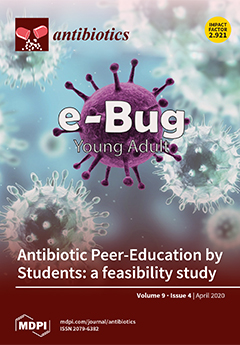The present study aimed to determine the bioactivities of essential oils extracted from the leaves of
Paramignya trimera and
Limnocitrus littoralis, including cytotoxicity, antiviral, antibacterial, antimycotic, and antitrichomonas effects. Herein, it was indicated that
P. trimera and
L. littoralis oils showed no
[...] Read more.
The present study aimed to determine the bioactivities of essential oils extracted from the leaves of
Paramignya trimera and
Limnocitrus littoralis, including cytotoxicity, antiviral, antibacterial, antimycotic, and antitrichomonas effects. Herein, it was indicated that
P. trimera and
L. littoralis oils showed no cytotoxicity on normal cells, namely MT-4, BHK-21, MDBK, and Vero-76.
P. trimera oil (i) exhibited the strongest inhibition against
Staphylococcus aureus with MIC and MLC values of 2% (
v/v); (ii) showed MIC and MLC values of 8% (
v/v) in
Candida parapsilosis; and (iii) in the remaining strains, showed MIC and MLC values greater than or equal to 16% (
v/v). On the other hand,
L. littoralis oil (i) displayed the strongest inhibition against
Candida tropicalis and
Candida parapsilosis with 2% (
v/v) of MIC and MLC; and (ii) in the remaining strains, possessed MIC and MLC greater than or equal to 16% (
v/v). In addition, antitrichomonas activities of the oils were undertaken, showing IC
50, IC
90, MLC values, respectively, at 0.016%, 0.03%, and 0.06% (
v/v) from
P. trimera, and 0.03%, 0.06%, 0.12% (
v/v) from
L. littoralis, after 48 h of incubation. The oils were completely ineffective against ssRNA+ (HIV-1, YFV, BVDV, Sb-1, CV-B4), ssRNA- (RSV, VSV), dsRNA (Reo-1), and dsDNA (HSV-1, VV) viruses. This is the first report describing the cytotoxicity, antiviral, antibacterial, antimycotic, and antitrichomonas activities of the essential oils of
P. trimera and
L. littoralis.
Full article






